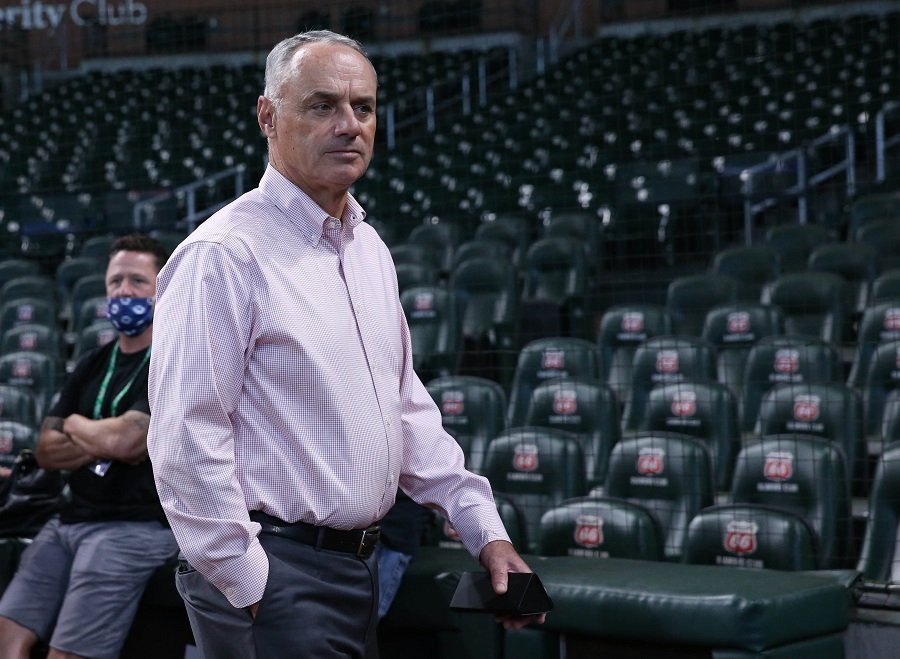Search the Community
Showing results for tags 'rob manfred'.
-
This offseason Major League Baseball decided to make rather sweeping rule changes. While we’ll see new base sizes, a pitch clock, and limited shifting, it’s the rule 2020 brought us that may continue to shake things up the most. Rob Manfred decided a runner will forever start on second during extra-...
-
Back in 2020, after a late start to the season following Covid-19, Major League Baseball decided to make doubleheaders seven-inning games and attempt to limit their length by placing a “ghost runner” on second base during extra innings. The pairing had some validity as rosters were tighter and a ris...
-
By now, if you’ve done any digging into the meaning behind the buzzword that “analytics” has become, you’ve become aware of Wins Above Replacement, or WAR. Today, Major League Baseball decided to take things a step further, and create a war between Baseball Reference and Fangraphs....
- 21 replies
-
- fangraphs
- baseball reference
-
(and 2 more)
Tagged with:
-
Thankfully this offseason we don’t have Major League Baseball owners delaying the start of 2023 through a lockout, but if you can think back to 2021 when that was the reality, an interesting proposal was made. Reporting from The Athletic’s Evan Drellich and Ken Rosenthal highlighted a desire for the...
- 21 comments
-
- fangraphs
- baseball reference
-
(and 2 more)
Tagged with:
-
Right now Major League Baseball may be as low as it’s ever been. Back during the 1994 and 1995 strike I was just five years old, way too young to be bothered by what was taking place. At this point in my life, it’s anything but. After Rob Manfred’s address yesterday I could produce nothing more than...
- 8 comments
-
- rob manfred
- lockout
-
(and 1 more)
Tagged with:
-
A contingent for both the owners and players arrived at Roger Dean Stadium in Florida on Monday. The respective sides have spent time meeting both separately and together. A handful of notes have been cycled through the days that have come and gone. Most notably, we’ve seen the players continuing to...
-
-
-
It’s not necessarily what has happened this week that makes it the most pivotal for CBA negotiations, but it is what’s to come. Rob Manfred hosted a joke of a press conference but revealed the owners would make another proposal on Saturday. From there, we’ll know how close we are to having baseball....
-
If you recalled from the update last week, it’s the Union that has made significant concessions. They also bent more this week after dropping their free agency timeline and revenue sharing requests. The discussions surrounding service time manipulation were shelved, and the pre-arbitration bonus poo...
-

Excitement is Coming, but is it Enough?
Ted Schwerzler posted a topic in Twins Daily Front Page News
Major League Baseball locked out its players on December 2nd. Since then, we have had virtually no baseball news and very little progress regarding the resumption of activity. Before that, though, there was madness. Eventually, we’ll get that madness again, but is it enough? If you’ve followed... -
If you’ve followed Major League Baseball for any period, you’re well aware that things get done within the funnel of time constraints. The trade deadline is when players get moved, like the day of, not weeks before. Free-agent signings happen during the Winter Meetings or as Spring Training begins....
-
After meeting for less than 10 minutes before locking out the players back in December and then spending more than 40 days before issuing a proposal, it’s noteworthy that the league engaged the union on consecutive days this week. The meeting results aren’t exactly heartwarming, but there’s a bluepr...
-
42 days had passed since Major League Baseball had met with the players union. Following his decision to lock out the players, Rob Manfred and the owners waited that amount of time to offer their proposal. Yesterday the event came and went. There was never expected to be a deal struck yesterda...
- 20 replies
-
- rob manfred
- major league baseball
-
(and 1 more)
Tagged with:
-
There was never expected to be a deal struck yesterday, but it is unfortunate to see the parameters of Major League Baseball’s proposal. As ESPN’s Jeff Passan outlined, the highlights were a slight raise in the minimum salary, draft pick incentivization to teams that don’t manipulate service time, a...
- 20 comments
-
- rob manfred
- major league baseball
-
(and 1 more)
Tagged with:
-
This space has been on pause the past few weeks because baseball has done absolutely nothing. This week that changed a bit, but I’m not sure it was for the better. We’re farther away from MLB’s return, and now worse off for it. Earlier this week one of the best reporters in the game, Ken Rosen...
- 11 replies
-
- jeff passan
- ken rosenthal
-
(and 1 more)
Tagged with:
-
Earlier this week one of the best reporters in the game, Ken Rosenthal, was let go from MLB Network. This stems from his criticism (and that should be used lightly) of overlord Rob Manfred. Major League Baseball’s commissioner is a steward of the owners, and while he actively seeks to line their poc...
- 11 comments
-
- jeff passan
- ken rosenthal
-
(and 1 more)
Tagged with:
-
Earlier this week, The Athletic’s Evan Drellich reported that while a handful of topics are to be discussed regarding a new CBA, core economic won’t be on the agenda until January. Since the lockout occurred on December 2nd, Major League Baseball appears comfortable taking their time; there have bee...
- 8 comments
-
- major league baseball
- rob manfred
-
(and 1 more)
Tagged with:
-
It’s been a slow couple of weeks with Major League Baseball effectively shut down. A few minor league transactions have trickled in, and a handful of stories regarding guys signing overseas have accumulated, but the lockout has drawn things to a halt. Recent reports don’t suggest a reprieve soon....
- 8 replies
-
- major league baseball
- rob manfred
-
(and 1 more)
Tagged with:
-
We’re now over a week into the lockout, and there hasn’t been a slew of developments. What is maybe most notable is that the league isn’t trying either. That’s not exactly shocking, given the owners have nothing to lose until games are lost, and with so much time before that reality, their incentive...
- 14 comments
-
- ken rosenthal
- jayson stark
-
(and 1 more)
Tagged with:
-
It’s been eight days since our last update, which not coincidentally came at the commencement of Major League Baseball deciding to lock out its players. After a flurry of moves in the leadup, we’ve now experienced the darkness of a league conducting no business. We’re now over a week into the...
- 14 replies
-
- ken rosenthal
- jayson stark
-
(and 1 more)
Tagged with:
-
Recent Articles
-
Recent Posts
-
3
Hey, look here
Whoooooooo Ranked ProspectsTurangChourioQueroFrelickBillWilburSpankyEdgarJohn NOOOOOOOOOO...
By Brock Beauchamp
Last post date -
0
Can Jorge López Rediscover His First-Half Success?
The Twins made a much-needed trade for an all-star reliever at last year’s deadline, but what they got fell short of e...
By Lou Hennessy
Last post date
-
Blog Entries
-
Who's Online (See full list)
- There are no registered users currently online





















